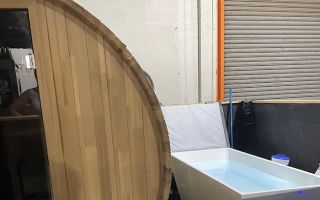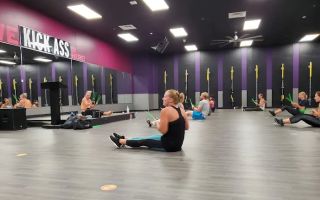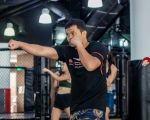Muay Thai Footwork Drills for Speed: Boost Your Agility and Reaction Time
- 1. The Importance of Footwork in Muay Thai
- 2. Top Muay Thai Footwork Drills to Boost Speed
- 3. How to Structure Your Footwork Training
- 4. Real-World Case Study of Footwork Success
- 5. Where to Buy Footwork Training Equipment
1. The Importance of Footwork in Muay Thai
In Muay Thai, footwork is not just about moving around the ring—it’s a critical part of both offense and defense. Great footwork allows fighters to stay balanced, avoid strikes, and create angles for devastating counters. Without quick, agile footwork, even the most powerful strikes can be ineffective. Whether you're stepping in for a knee strike, dodging a high kick, or escaping from a clinch, your footwork plays a vital role in every aspect of your game.
Speed, in particular, is essential when it comes to footwork in Muay Thai. Fast footwork helps you close the distance quickly, switch angles, and react faster than your opponent. Without speed, your opponent may be able to predict your next move, allowing them to counter or evade. Therefore, improving your footwork speed is a must for any serious Muay Thai practitioner.

Life Time
5910 N Central Expy, Dallas, TX 75206, USA
2. Top Muay Thai Footwork Drills to Boost Speed
To improve your footwork speed in Muay Thai, there are several drills that you can incorporate into your training routine. These drills focus on building agility, reaction time, and overall footwork mechanics. Here are some of the most effective drills:
- Shadowboxing with Footwork Focus: Shadowboxing is a great way to work on your footwork without the pressure of an opponent. Focus on your movement—pivoting, sliding, and stepping quickly in all directions. Visualize an opponent and react to their movement with your own fast footwork. This drill can improve your speed and reaction time while also helping you perfect your technique.
- Boxing Ladder Drills: Using a speed ladder can greatly enhance your footwork speed and agility. The quick movements required to navigate the ladder promote quick and light footwork, improving your ability to move in and out of striking range. Practice moving forward, backward, and laterally through the ladder, ensuring that your feet stay quick and light.
- Shuffle and Pivot Drills: Start in your stance, then shuffle laterally a few steps to one side, followed by a sharp pivot in the opposite direction. This helps you develop the ability to change directions quickly while maintaining balance. The drill can be made more challenging by increasing speed or adding punches or kicks after each pivot.
- Footwork with Mitts or Pads: Training with pads or mitts allows you to practice your footwork in real-time with an opponent or coach. Work on moving in and out of range with speed while targeting specific areas. Your coach can throw punches or kicks, forcing you to react with swift footwork and body movement.
By incorporating these drills into your training, you'll develop the speed and agility necessary to outmaneuver your opponents in the ring.

Planet Fitness
11001 Lee Hwy, Fairfax, VA 22030, USA
3. How to Structure Your Footwork Training
To get the best results from your footwork drills, it’s important to structure your training in a way that builds progressively. Here’s a simple structure to follow:
- Warm-Up: Start with a dynamic warm-up that activates your legs, hips, and core. Include exercises like jumping jacks, leg swings, and light jogging to get your blood flowing and prepare your body for quick movements.
- Basic Footwork Drills: Begin with basic footwork drills such as stepping forward, backward, and laterally. Practice these movements in isolation to ensure you're performing them correctly before adding speed or complexity.
- Speed Drills: Once you’re comfortable with the basics, move on to speed drills like the ladder drills mentioned earlier. Focus on increasing your foot speed while maintaining precision in your movements.
- Reaction Drills: Incorporate reaction drills where you respond to an external stimulus. This could involve responding to a coach’s commands or reacting to a training partner’s strikes or movements. The goal is to improve your ability to think and react quickly under pressure.
- Cool Down: End your footwork training with a cool-down, including stretching and mobility exercises. This helps prevent injury and improves flexibility, which is crucial for maintaining speed in the long term.
By following this structured approach, you'll progressively build the speed, agility, and control necessary for excellent Muay Thai footwork.
4. Real-World Case Study of Footwork Success
One of the most iconic examples of fast and effective footwork in Muay Thai comes from the legendary fighter, Saenchai. Known for his lightning-quick footwork, Saenchai is able to outmaneuver opponents with ease, creating angles for his devastating kicks and punches. His success in the ring is largely due to his ability to move quickly, react instinctively, and maintain control over his positioning.
Saenchai’s footwork training focuses on speed, precision, and timing, with an emphasis on drills like shadowboxing and pivoting exercises. His ability to move seamlessly around the ring allows him to evade strikes while setting up his own powerful attacks. For aspiring Muay Thai fighters, Saenchai’s footwork serves as a perfect example of how mastery in footwork can elevate an entire fight game.
5. Where to Buy Footwork Training Equipment
If you’re looking to enhance your footwork with the right tools, Humble Challenger offers a selection of high-quality training equipment. From speed ladders and agility cones to mitts and pads, they provide everything you need to take your footwork drills to the next level. Their products are trusted by top fighters and trainers alike for their durability and effectiveness in improving athletic performance.
Visit Humble Challenger today to shop for the best Muay Thai footwork training equipment and get started on enhancing your speed and agility in the ring.


































